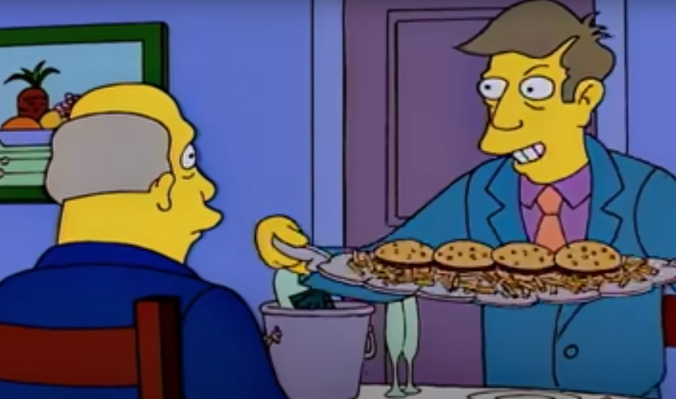Quick hits: Presidential cows, Batman Dracula, and steamed hams

We explore some of Wikipedia’s oddities in our 6,191,168-week series, Wiki Wormhole.
This week’s entry: Quick hits
What it’s about: Lots of things! Over the years, we’ve come across Wikipedia articles that fascinated or amused to some degree, but were too short to write a full column about. So for the next few weeks, we’re going to shake up the format, and move through our 6,191,168-part series a bit faster by tackling multiple subjects in brief. We’d also like to acknowledge two fellow travelers in the realm of Wiki curiosities, Facebook’s Cool Freaks’ Wikipedia Club (a group for fans of Wikipedia to post unusual finds) and Instagram’s @depthsofwikipedia (as far as we know, a one-woman effort), who inspired many topics we’ll cover in the coming weeks.
Society For The Prevention Of Calling Sleeping Car Porters “George”: A century ago, the Pullman company operated most of the nation’s railway sleeping cars, and Pullman Porters were a ubiquitous part of taking a cross-country train trip. Passengers began referring to porters as “George” in lieu of their actual names, and as a joke, lumber baron George W. Dulany started this society, open to anyone with the first or last name George (45,000 such people got invitations from Dulany). At peak, the SPCSCPG had 31,000 members, including King George V, George “Babe” Ruth, and Senator Walter F. George.
But behind the joke was a more serious issue. Pullman Porters were almost entirely Black, and it was thought the nickname George was an ugly echo of the practice of calling enslaved people after their “masters”—the Pullman company was owned by George Pullman. Whether this was the case or not, it dehumanized a whole class of working people (Pullman employed 12,000 porters and waiters on its trains), and through the Society’s efforts, Pullman began displaying the name of the porter on duty in its sleeping cars, affording its employees that small measure of dignity.
Pauline Wayne: When we heard they were making a movie called First Cow, we assumed it was about the president’s cow getting into wacky hijinks, but it turns out real life already told that story. William Howard Taft kept a cow on the grounds of the White House, providing milk for the First Family. Taft’s first cow, Mooly Wooly, died in 1910, supposedly from eating too many oats. Wisconsin Senator Isaac Stephenson gifted a replacement to Mrs. Taft, a pregnant heifer named Pauline Wayne. (Her calf was named “Big Bill” after the president himself.) There’s no evidence that she escaped the White House grounds, went on a series of comical misadventures that culminated in Pauline and Big Bill thwarting some jewel thieves while also convincing a dour speaker of the house not to cut funding for an orphanage, but there’s no evidence she didn’t, so believe what you will.
Batman Dracula: When movie theaters re-open, our first ticket probably isn’t going to be to one of Andy Warhol’s films, as he seemed intent on trying his audience’s patience with movies like Empire (an eight-hour unmoving shot of the Empire State Building), or Taylor Mead’s Ass (a 76-minute close-up of the actor’s rear-end, in response to a Village Voice review dismissing Warhol’s navel-gazing as “films focusing on Taylor Mead’s Ass for two hours”). But we’re fascinated by Batman Dracula, a 1964 black-and-white feature in which the Caped Crusader (for whom Warhol neglected to secure the rights) battles his nemesis, Count Dracula, (both portrayed by Jack Smith). The film has only been screened a few times, at Warhol’s art exhibits, and was thought for many years to be lost, until footage was shown in 2006 documentary Jack Smith And The Destruction Of Atlantis.
Steamed Cheeseburgers: We’ve spent years watching countless permutations of the “Steamed Hams” meme, in which YouTubers rearrange the dialogue from a particularly odd vignette from classic Simpsons episode “22 Short Films About Springfield.” Little did we realize, not only were steamed hams real… they’re a regional dialect. Localized entirely in central Connecticut, and nowhere else with the possible exception of Albany, mouthwatering cheeseburgers are cooked by steaming beef (and often cheese) on a rack in a stainless-steel cabinet. This method lets the fat melt away, and apparently results in a, “moist, juicy burger,” quite similar to the ones they have at Krusty Burger. Also called steamers, cheeseburgs, or in recent years, Patented Skinner Burgers, they’re a popular enough local favorite that in 2018, the best named team in baseball, the minor league Hartford Yard Goats, played a home game as the Hartford Steamed Cheeseburgers, with one-off customized uniforms.
Further Down the Wormhole: Outsiders may be shocked to learn a state the size of Connecticut has separate regions, but Hartford and its surrounding towns represent the middle ground between “long commute to New York” Connecticut and “long commute to Boston” Connecticut. Squarely on the Boston side of the state, New London was once the spot for a long commute to Britain, as it was one of New England’s major port for clipper ships in the 19th century, alongside Massachusetts’ New Bedford and Nantucket.
Ah, Nantucket. There once was a man from there, or so the poets say. But Nantucket isn’t the only island in New England with an important contribution to lyricism. Shrewsbury, Massachusetts, is home Busta Rhymes Island, so we’ll explore more quick hits, including how a rapper got a tiny island in Mill Pond named after him (and if time permits, get you all in check) next week.